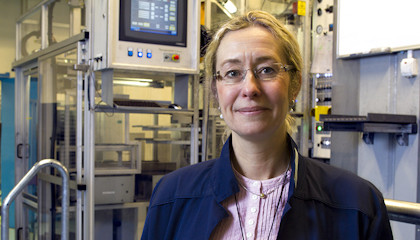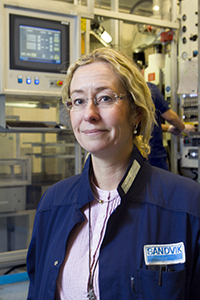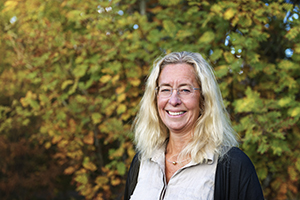An innovative mind

Sandvik’s Susanne Norgren is passionate about materials. By changing a material’s properties you can change its design and ultimately the end product – creating tomorrow’s materials. So far Norgren’s work has led to more than 380 patents.
“If you replace the steel used in the Eiffel Tower with today’s modern steel, you would be able to build four Eiffel Towers with the same amount of steel, based on weight, as the original,” says Susanne Norgren, Group expert materials design and an adjunct professor at Uppsala University. “It’s all about the properties of a material, and how you could change them and change the actual design of the material. I find that fascinating.” Susanne Norgren's innovative mind is always trying to find new ways to maximize a material's efficiency.
Susanne Norgren's innovative mind is always trying to find new ways to maximize a material's efficiency.
Norgren has worked in all of Sandvik’s business areas, studying, developing and designing new materials. In 2013, she became Group Expert, one of two persons to have the title, which is the highest level within Sandvik’s expert career path. She is also in a top position in terms of the number of patents to her credit, with more than 380 to date.
Success, however, says Norgren, is a team sport. “Behind every patent or new design there’s a large group of people with huge knowledge in their respective field,” she says. “I love to assemble strategic research teams and connect people with different competencies and ask them difficult or challenging questions and watch them get started and grow as a team.”
Years in the making
Sometimes the path from idea to finished product or process can take some time. Years actually.
“With fine-grained gamma-phase, which is used within the new line of turning tools from Sandvik Coromant, I had the idea and applied for the patent based on the lab results. However, there was no process technology in place to actually start using it. This is where my skilled and dedicated colleagues stepped in and created the process technology and production equipment. A stage that can take up to ten years depending on the level of complexity,” she explains.
Norgren knows exactly when her interest in materials design began. She relates that while she’d always liked mathematics, physics and chemistry, it was a talk she heard in high school that awakened her to this career path. Representatives from the KTH Royal Institute of Technology came to her class to talk about materials design and the possibilities of studying it at a university level. “I instantly felt that this is what I should study,” Norgren recalls. “It was a combination of all the subjects I liked.”
Having an innovative mindset
For Norgren it was also a eureka moment when she realized one can design a material based on the targeted properties.
“Take a cellular phone as an example,” she says. “Remember what they first looked like and what they look like today. They have developed not only because of technical advances but also because of the material they’re made of, which provides new properties, functionalities and new possibilities for design. New materials and properties are enablers to change what you have around you.”

Or, as with the patent Norgren is proudest of, a biocompatible titanium-implant material for bone screws, made possible thanks to the material design and properties.
“It’s a biocompatible titanium alloy for implants, without aluminum and vanadium, the most common alloying elements for titanium alloys, which are substances harmful to the body.”
Affecting the whole value chain
At the moment, a major focus for Norgren and the industry is the trend towards electrification in such segments as the automotive industry. This trend puts enormous demands on processes, applications and new materials, she says.
“It affects the whole value chain,” Norgren explains, “from the mine where new raw materials are in demand to the metal-cutting industry where new cutting tools and processes are needed – not least when it comes to additive manufacturing.”
There’s no doubt that challenges are ahead, but that’s the way Susanne Norgren wants it, to continue her path working both in R&D and in strategic research in a university environment, so she can keep asking those difficult questions.